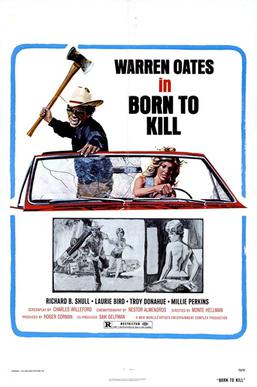
Roger William Corman is an American film director, producer, and actor. He has been called "The Pope of Pop Cinema" and is known as a trailblazer in the world of independent film. Many of Corman's films are based on works that have an already-established critical reputation, such as his cycle of low-budget cult films adapted from the tales of Edgar Allan Poe.

Warren Mercer Oates was an American actor best known for his performances in several films directed by Sam Peckinpah, including The Wild Bunch (1969) and Bring Me the Head of Alfredo Garcia (1974). Another of his most acclaimed performances was as officer Sam Wood in In the Heat of the Night (1967). Oates starred in numerous films during the early 1970s that have since achieved cult status, such as The Hired Hand (1971), Two-Lane Blacktop (1971), and Race with the Devil (1975). Oates also portrayed John Dillinger in the biopic Dillinger (1973) and as the supporting character U.S. Army Sergeant Hulka in the military comedy Stripes (1981). Another notable appearance was in the classic New Zealand film Sleeping Dogs (1977), in which he played the commander of the American forces in the country.

Two-Lane Blacktop is a 1971 American road movie directed by Monte Hellman, written by Rudy Wurlitzer and starring songwriter James Taylor, the Beach Boys drummer Dennis Wilson, Warren Oates, and Laurie Bird.

Charles Ray Willeford III was an American writer. An author of fiction, poetry, autobiography, and literary criticism, Willeford is best known for his series of novels featuring hardboiled detective Hoke Moseley. Willeford published steadily from the 1940s, but vaulted to wider attention with the first Hoke Moseley book, Miami Blues (1984), which is considered one of its era's most influential works of crime fiction. Film adaptations have been made of four of Willeford's novels: Cockfighter, Miami Blues, The Woman Chaser, and The Burnt Orange Heresy.

Ride in the Whirlwind is a 1966 American Western film directed by Monte Hellman and starring Cameron Mitchell, Millie Perkins, Jack Nicholson, and Harry Dean Stanton. Nicholson also wrote and co-produced the film. A trio of cowboys are forced to become outlaws due to a case of mistaken identity by the local authorities.

The Shooting is a 1966 American Western film directed by Monte Hellman, with a screenplay by Carole Eastman. It stars Warren Oates, Millie Perkins, Will Hutchins, and Jack Nicholson, and was produced by Nicholson and Hellman. The story is about two men who are hired by a mysterious woman to accompany her to a town located many miles across the desert. During their journey, they are closely tracked by a black-clad gunslinger, who seems intent on killing all of them.

The Terror is a 1963 American independent horror film produced and directed by Roger Corman. The film stars Boris Karloff and Jack Nicholson, the latter of whom portrays a French officer who is seduced by a woman who is also a shapeshifting devil.

Monte Hellman was an American film director, producer, writer, and editor. Hellman began his career as an editor's apprentice at ABC TV, and made his directorial debut with the horror film Beast from Haunted Cave (1959), produced by Gene Corman, Roger Corman's brother.

Carnosaur is a 1993 American science fiction horror film written and directed by Adam Simon. The film stars Diane Ladd, Raphael Sbarge, Jennifer Runyon, and Harrison Page. Loosely based on the 1984 John Brosnan novel of the same name, it follows characters Doc Smith and Ann Thrush in their efforts to thwart Dr. Jane Tiptree's plan to exterminate the human race with a lethal virus and replace them with her own genetically created dinosaurs.
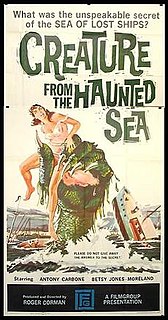
Creature from the Haunted Sea is a 1961 horror comedy film directed by Roger Corman. Written by Charles B. Griffith, the film is a parody of spy, gangster, and monster movies, concerning a secret agent, XK150, who goes under the code name "Sparks Moran" in order to infiltrate a criminal gang led by Renzo Capetto, who is trying to transport an exiled Cuban general with an entourage and a large portion of the Cuban treasury out of Cuba. Filmgroup released the film as a double feature with Devil's Partner.

Beast from Haunted Cave is a 1959 horror/heist film directed by Monte Hellman and starring Michael Forest, Frank Wolff and Richard Sinatra. It was produced by Gene Corman, Roger Corman's brother. Filmed in South Dakota at the same time as Ski Troop Attack, it tells the story of bank robbers fleeing in the snow who run afoul of a giant spider-like monster that feeds on humans. The film was released as a double feature with The Wasp Woman (1959).
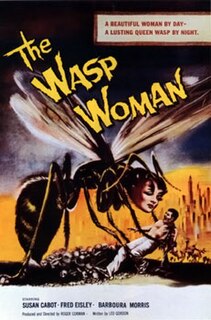
The Wasp Woman is a 1959 American independent science-fiction horror film produced and directed by Roger Corman. Filmed in black-and-white, it stars Susan Cabot, Anthony Eisley, Michael Mark, and Barboura Morris. The film was originally released by Filmgroup as a double feature with Beast from Haunted Cave. To pad out the film's running time when it was released to television two years later, a new prologue was added by director Jack Hill.

Avalanche Express is a 1979 Cold War adventure thriller film starring Lee Marvin, Robert Shaw, Maximilian Schell, and Linda Evans and produced and directed by Mark Robson. The plot is about the struggle over a defecting Russian general. The screenplay by Abraham Polonsky was based on a 1977 novel by Colin Forbes.
Acid Western is a subgenre of the Western film that emerged in the 1960s and 1970s that combines the metaphorical ambitions of critically acclaimed Westerns, such as Shane and The Searchers, with the excesses of the Spaghetti Westerns and the outlook of the counterculture of the 1960s, as well as the increase in illicit drug taking of, for example, cannabis and LSD. Acid Westerns subvert many of the conventions of earlier Westerns to "conjure up a crazed version of autodestructive white America at its most solipsistic, hankering after its own lost origins".
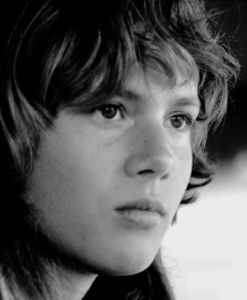
Laurie Bird was an American film actress and photographer. She appeared in three films during the 1970s. Two of them were directed by Monte Hellman. She was romantically involved with Hellman and Art Garfunkel, committing suicide in the latter's apartment by taking an overdose of Valium.

Iguana is a 1988 American adventure drama/thriller film directed by Monte Hellman and starring Everett McGill in the main role. The movie is based on the novel by Spanish author Alberto Vázquez-Figueroa, itself based on the life of a real Irish sailor called Patrick Watkins. The movie was mainly shot on location in Lanzarote. Monte Hellman won Bastone Bianco Award for this movie on the Venice Film Festival in 1988. Iguana premiered in theaters on April 1, 1988, and was released on DVD on January 30, 2001 via Anchor Bay Entertainment. The movie ends with the titles "For Warren" as Hellman dedicated the film to his friend Warren Oates who died in 1982.
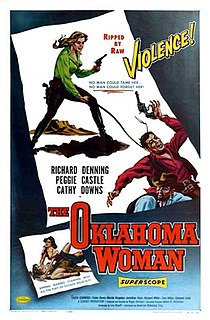
The Oklahoma Woman is a 1956 American Western film directed by Roger Corman.

A Time for Killing is a 1967 Western film directed originally by Roger Corman but finished by Phil Karlson. Filmed in Panavision and Pathécolor, it stars Glenn Ford, George Hamilton, Inger Stevens, and Harrison Ford in his first credited film role.
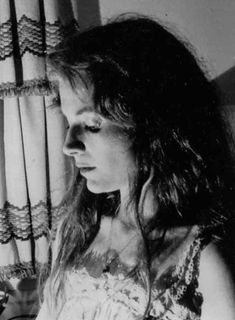
Patricia Sue Pearcy is an American film, stage, and television actress. She began her career in theatre, appearing on Broadway and in local theatre companies in Connecticut and Kentucky before making her film debut in Monte Hellman's Cockfighter (1974).

Steven Gaydos is an American screenwriter, songwriter, and journalist.

